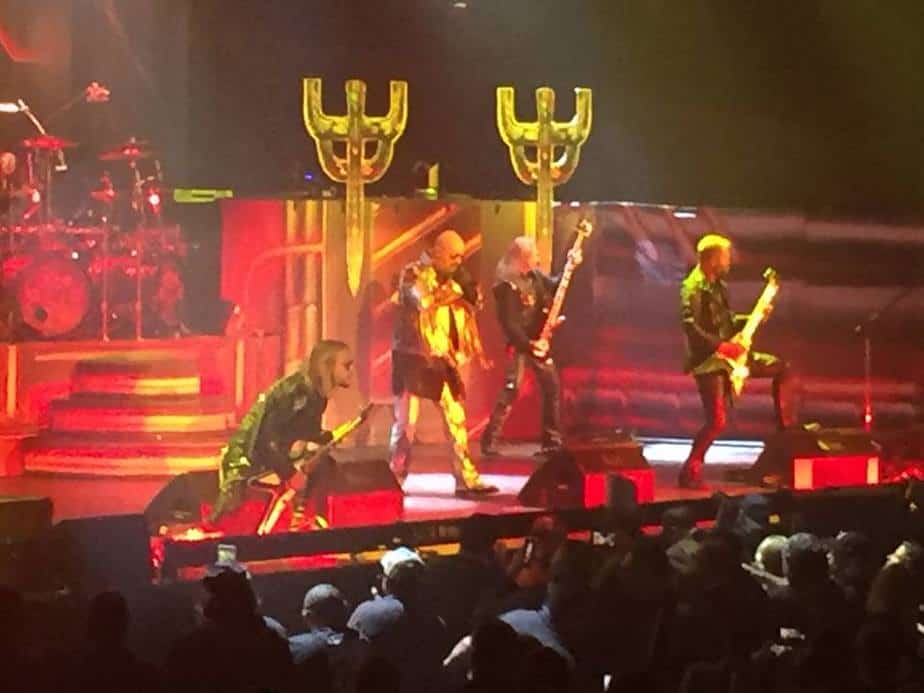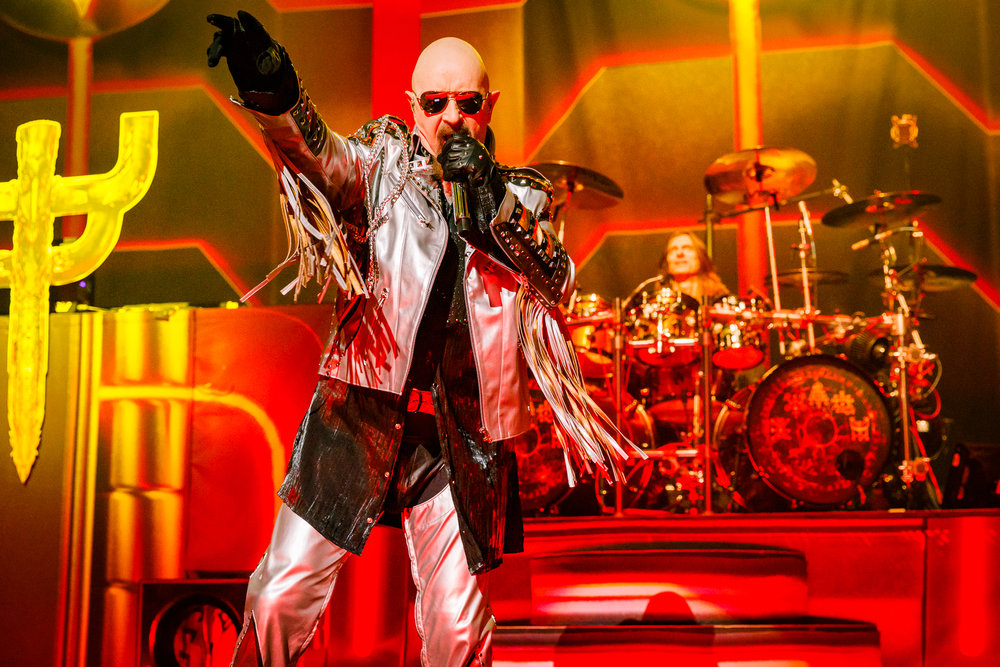Index
Two generations of Britmetal slammed out their wares at FivePoint Amphitheater in Irvine, California, on September 27 as Deep Purple headlined the show that Judas Priest opened, with two different kinds of metalheads banging in support of each.
And while both bands have been presenting said wares for more than four decades, each demonstrated that it still had a trick or two up its sleeve even as both reliably fired off the hallmarks that eventually landed one band in the Rock and Roll Hall of Fame while the other is on the short list of the Rock Hall's biggest "snubs." So, did one band justify its inclusion? And did the other further its case for inclusion?
For those breathlessly awaiting the conclusion of my cut-price concert-ticket saga of 2018, I will try to answer those questions here. The Purple-Priest concert was the other half of my quid pro quo with my friend Kathie, as I had agreed to see Poison and Cheap Trick back in May if she would see Deep Purple and Judas Priest. Certainly for a straight-up $20 (US) ticket price (no fees!) and FivePoint still offering free parking—why not? the parking lot sits at the end of a disused two-mile-long runway on a decommissioned Marine Corps air base—both shows were a bargain for a night out to hear some live commercial hard rock.
Meanwhile, Back at the Carnival . . .
As the only large-scale outdoor concert venue in south Orange County, Irvine's FivePoint Amphitheater promises to be a local fixture for some time to come, replacing the late, lamented Irvine Meadows, which hosted a wealth of artists across all musical forms for 35 years. The 12,000-seat FivePoint has already hosted a good variety of artists since its inception in 2017, including a number of metal acts this year alone—Anthrax, Queensrÿche, the Scorpions, Slayer, Testament, and Whitesnake—with Danzig still to come.
All that remains is for FivePoint to go from traveling carnival to permanent fixture. Currently, it features three banks of steel bleachers facing a modest stage, with a grassy area in between, and a ring of concession stands, merchandising kiosks, and portable restrooms assembled behind the bleachers. It has the ambience of the local fair, but even the Orange County Fairgrounds are a permanent locale with both an established indoor and outdoor concert venue (the Hangar and the Pacific Amphitheater, respectively).
Development of a permanent FivePoint site may depend on how development of the former Marine Corps Air Station El Toro proceeds in the coming years. Having given an overview of the real estate saga in this choice corner of Orange County the last time, I won't belabor the point again except to note that as we drove to FivePoint while trying to follow the hardly-explicit indicators of exactly where to go to find the amphitheater, Kathie and I got a look at the not-quite-aesthetically-pleasing faux-Mediterranean condominium and apartment-home colonies that are beginning to spring up like garish mushrooms on this prized property. I can't say that the old base housing was any better, but although the current FivePoint might look like a traveling carnival, I hope it doesn't become transformed into an eyesore complement to those condos.
Priest Unleashed: Long Live the Beast?
Having joined Deep Purple for the North American leg of its Long Goodbye Tour, Judas Priest is hardly along for the ride to peddle mere nostalgia. The quintet, which released its first album forty-four years ago (Rocka Rolla, [Gull, 1974]), is touring to promote its latest album, Firepower (Epic, 2018), so it was no surprise that one-quarter of the band's set list featured tracks from its eighteenth studio album, and on the basis of those four songs, Priest seems to have hardly lost any of that vaunted firepower.
Rock legend Judas Priest generates heavy-metal intensity at FivePoint Amphitheater in Irvine, California, September 27, 2018.
Along with Iron Maiden and Motörhead, Judas Priest is often included among the Big Three of the New Wave of British Heavy Metal that also includes Def Leppard, Saxon, Venom, and a host of others. On the other hand, Priest is sometimes excluded because it had been releasing albums since 1974, this despite the fact that the band's 1977 album Sin after Sin (CBS/Columbia) premiered its revamped style exemplified by the growling "Dissident Aggressor," which quickly inspired many NWOBHM imitators.
In any event, that late-1970s new wave revitalized the early metal scene with a harder, faster, and, at least via Motörhead, punk-edged approach that soon proved influential on 1980s speed- and thrash metal. Priest in particular provided this primer in the new metallurgy to neophytes; as critic Mark Coleman observed, "As long as there's heavy metal, Judas Priest will continue to administer the rites of passage to an eager audience."
The audience at the FivePoint Amphitheater seemed quite eager to participate in those rites of passage—and to tell from the subtle thinning of the crowd after Priest's set, that audience was perhaps less eager to learn about Purple's passages (to pun on a long-forgotten Deep Purple compilation). That is ironic as Judas Priest's beginnings put it closer to Purple than might be assumed, which makes their pairing for this tour less puzzling than it may seem.
Midlands Beginnings and Woodshedding
The band got its start in 1969 in West Bromwich, outside Birmingham in England's West Midlands, and took its name from the Bob Dylan song "The Ballad of Frankie Lee and Judas Priest" featured on Dylan's acoustical John Wesley Harding album. These roots don't seem to scream heavy metal, but this is a band that later managed to reel in covers of Peter Green's "The Green Manalishi (with the Two-Pronged Crown)" from the early Fleetwood Mac catalog and even Joan Baez's celebrated reflection on her failed relationship with Dylan, "Diamonds and Rust," within its pounding purview.
However, this early Priest folded by the following year, with original singer Al Atkins joining a hard-rock outfit called Freight that included guitarist K.K. Downing and bassist Ian Hill. They soon reclaimed the defunct Judas Priest's name, and when Atkins and drummer Alan Moore quit, they were replaced by singer Rob Halford and drummer John Hinch, both from a band called Hiroshima (not the American jazz-fusion band). By 1974 they signed a recording deal with Gull Records, which recommended adding a second lead guitarist, Glenn Tipton, to bolster the band's attack.
Priest in Its Prime—And Cinematic Glory?
These four—Downing, Halford, Hill, and Tipton—formed the core of Judas Priest for fifteen years, during the heart of the band's success and influence, until Halford left the band in 1991 to form a thrash-metal band, Fight. To replace him, the band recruited Tim "Ripper" Owens, an American who had sung in a Priest tribute band called British Steel, a situation that inspired the 2001 movie American Hero starring Mark Wahlberg, although Judas Priest, despite offering its assistance to the filmmakers, has disavowed any connection to it other than the initial motivating circumstance. Owens appeared on two studio albums and two live albums and had even been nominated for a Grammy Award for Best Metal Performance in 1999.
Since its inception, Priest has gone through eight drummers, six of whom appeared on at least one studio album. That brings to mind a running joke in the 1984 "mockumentary" film This Is Spinal Tap as that venerable band also experienced suspicious attrition in the percussion section.
Indeed, Judas Priest has long been on the short list of actual rock bands considered to be the real Spinal Tap, buttressed by Priest's conventional rock roots and even an early appearance on the British television music program The Old Grey Whistle Test looking like Lynyrd Skynyrd castoffs, replete with Halford's flowing Ronnie Van Zant locks, on "Rocka Rolla" and "Dreamer Deceiver / Deceiver." And as the apocryphal story goes, Priest claimed that the night after seeing Spinal Tap, it too got lost in the hinterlands of a concert hall while trying to find its way onstage. (According to Tap's Christopher Guest, that inspiration comes from seeing a tape of Tom Petty playing at a venue in Germany and winding up at an indoor tennis court.)
Twenty-first Century Survivors
In 2003, Rob Halford reunited with Judas Priest, which now included American drummer Scott Travis, who has been with the band continuously since 1989. Priest released two albums, the self-referential Angel of Retribution (Epic, 2005) and the pretentious Nostradamus (Epic, 2008), before K.K. Downing announced his retirement from the band in 2011; English guitarist Richie Faulkner has filled his position since then.
Downing's motivations for retirement remain contentious and were revisited when, in early 2018, Glenn Tipton, who appears on Firepower, announced that his Parkinson's disease, first diagnosed a decade previously, had progressed to the point that he would be unable to continue playing. For Judas Priest's current tour, Firepower's co-producer Andy Sneap joined as the second lead guitarist, a move that surprised Downing, who expected to get the call to take Tipton's place; that in turn surprised the band, which did not think Downing wanted to return.
On with the Show
But as Judas Priest's walk-up music, Black Sabbath's immortal "War Pigs," boomed from the FivePoint Amphitheater's loudspeakers, the band—Halford, Faulkner, Sneap, Hill, and Travis—had no problem negotiating its way backstage as it hit the boards with Firepower's title track, a driving rocker bursting with trademark guitar riffs and Halford's equally distinctive vocals, forceful growls slipping into register-piercing shrieks, before reaching back four decades for the swaggering "Delivering the Goods" and "Sinner," the oldest songs in the band's fifteen-song set, which mark the transition from Black Sabbath-styled early-1970s metal to the more familiar late-1970s New Wave of British Heavy Metal that Priest pioneered.
With a bushy goatee to go with his patented chrome dome, 67-year-old Rob Halford may well be on his way to becoming the Keeper of Traken from an old Doctor Who serial, but although he might have lost a few steps from his younger days, he took quiet command of the stage with deliberate pacing and with a series of striking, elaborate, long coats that would make even Elton John in his prime green with envy and that he seemed to change with every song, finally prompting Kathie to mutter, "Boy, I'd love to have his coats."
Priest lead singer Rob Halford still looks resplendent as he initiates another generation of metal fans with his distinctive vocals.
Apart from Halford, the spotlight fell on Faulkner, who with his long blonde hair, white sleeveless T-shirt, and white Gibson Flying V looked like a ringer for Downing and was firing off stinging riffs and furious licks, occasionally goosed by his whammy bar, in a similar manner. But except for Travis's slams and rolls, Hill and Sneap found themselves buried in the mix while Halford's vocals could have used some separation and clarity to keep them from getting lost in the thunder.
Nevertheless, Priest's set list was built with a couple of effective strategies in mind. Returning to another pulsing rocker from Firepower, the early-Metallica-like "Lightning Strike," the band then dipped into a deep cut, the ruminative "Desert Plains" from Point of Entry (Columbia, 1981), before rolling out another Firepower track, the anthemic if overly familiar "No Surrender." (And sorry, Point of Entry fans, but no "Heading out on the Highway" this time out.) A run through "Turbo Lover"—which may never escape its synthetic, mid-1980s feel—hinted at the big hits to come before a final visit to Firepower and "Rising from Ruins," a throbbing epic that gave Faulkner space to wail.
Having laced the Firepower tracks it wanted to promote with a canny selection of older songs for the faithful, Judas Priest turned to sheer crowd-pleasing in the second half of its hour-plus set. Granted, "Freewheel Burning" might still sound as if it's trying too hard to overwhelm you, but the half-dozen classics Priest closed with—including the manic (if slightly overlong) rip through "Painkiller"—are a tough survey to beat.
Hot on the heels of "Freewheel Burning" came "You Got Another Thing Comin'," from 1982's Screaming for Vengeance (Columbia), the album that established the band in the US, highlighted by the well-crafted, hook-laden "You Got Another Thing Comin'," Priest's only single to break into Billboard's US Hot 100 (albeit reaching a modest Number 67). With its punchy dynamics, strutting attitude, and catchy chorus that showcases Halford's vocals to their best advantage, "You've Got Another Thing Comin'" remains a Priest touchstone.
Also pulled from Screaming for Vengeance was the relentless blast of "Electric Eye," its techno-surveillance paranoia another ideal setting for Halford's scarifying voice. And no Judas Priest concert would be complete unless Halford rides onto the stage atop a Harley, with that biker imagery, along with suggestions of the BDSM and gay subcultures, manifest in "Hell Bent for Leather," another signature anthem, although not quite as definitive as the pair of songs that closed the set.
British Steel (Columbia, 1980) was the album that established Judas Priest in the United Kingdom—it is still the band's highest-charting album there—and one that piqued serious interest in the United States with its spare, muscular sound and brash, cavalier pose. Emblematic of that are the pair of singles that have shaped impressions of Judas Priest for nearly forty years. "Breaking the Law" delivers exactly what it says on the label—desperate circumstances call for illegal measures—with a forceful riff, a clipped refrain, and a quick getaway as it doesn't belabor its point.
Even better is "Living After Midnight," which blends the band's inherent hard-rock emphasis with an instinctive pop sensibility along with, crucially, judicious restraint that leaves the listener wanting more, not less, as its forceful drumming, slamming guitar riff, and Halford's cocksure lyrics encapsulate hallmark metal attitudes. For my money, it's Priest's quintessential song.
It was surely a fitting high note on which Priest ended its set, to the delight of the band's many supporters, a number of whom seemed fit to leave once Judas Priest exited the stage. For its part, Priest made sure to promote its new album, which based on the four cuts exhibited here is a rousing return to form if nothing new, and to satisfy the fanbase with a couple of surprises spicing up an expected menu of classics.
Judas Priest's Legacy: Worthy of the Rock and Roll Hall of Fame?
Effecting a transition from the first generation of British heavy metal to the next as it straddled the two generations, Judas Priest has been, as Mark Coleman noted, the conductor of those heavy metal rites of passage for the uninitiated. For subsequent generations, including I suspect many in the audience with us at FivePoint, Priest has provided the primer that has oriented metal acolytes with the basics of the genre, at least for the state of the genre from the late-1970s to the end of the 1980s.
But Judas Priest lacks the basic imagination, sustained inspiration, or sheer chutzpah to make a successful bold statement in a single song, let alone over the course of an entire album. Let's face it: the band has thrown an awful lot against the wall to get "You've Got Another Thing Comin'," "Living After Midnight," and a handful of others to stick—and even they are not brilliant songs as much as they are highly competent ones, although metal fanatics, like fanatics of any rock genre, are sure to disagree passionately.
In terms of legacy, does Judas Priest, currently ranked Number 10 on the Not in Hall of Fame website among artists not yet inducted into the Rock and Roll Hall of Fame, deserve to be in the Rock Hall? Yes, although among the Big Three of the New Wave of British Heavy Metal, it lacks the distinction of the other two.
Still headbanging after four decades: Is it time for Judas Priest to be inducted into the Rock and Roll Hall of Fame?
Iron Maiden aspired to create musical sagas inspired by literary classics (or at least by the titles of literary classics), but evincing the lyrical weight of a high school book report, the band's reach surely exceeded its grasp even if its rhythmic drive and twin-guitar attack provided just compensation. Still, Maiden exhibited ambition that generated a fair degree of interest.
And while Motörhead seemed at first glance to be crude, coarse, and simplistic, its raw, thunderous drive instilled a sense of genuine menace while its blunt songs spit out intelligence, attitude, and, crucially, wit. (C'mon, "Killed by Death" is hilarious—and Lemmy knew it as well. Too bad Death got the last laugh.) Moreover, Motörhead's wedding of punk and metal proved highly influential on underground- and alternative-rock bands from the 1980s and beyond.
I won't deliver the weaselly assessment that "yes, Priest belongs in the Hall of Fame—but Iron Maiden and Motörhead need to go in first" if only because the Hall's nomination and voting processes are so hopelessly ballsed-up that by now I'm convinced that any "snub" is more likely a result of gross incompetence than sneering elitism. In other words, "going in first" is less a function of merit as it is happenstance. But Judas Priest, despite its decades of initiations, does not rise to the heights attained by Iron Maiden and Motörhead. (Judas Priest did receive its first ballot nomination for the Rock Hall in 2018.)
That said, did Judas Priest's show at FivePoint do anything to help its Hall of Fame case? Yes, it did. Even though its two (near-)charter members, Rob Halford and Ian Hill, qualify as "pensioners" in British parlance, this legendary heavy metal band is still "Delivering the Goods," both the classic tracks that make the band's case and the current ones that augment it. The rabid fans at least in our section seemed to come away satisfied with that.
My only regret is that Priest's extended set, preceded by the Scottish blues-rock outfit the Temperance Movement, cut into the amount of time that Deep Purple had for its set. Not that that long-running band has anything to prove now, but my curiosity was still piqued to see how Purple would handle its change in fortune.




Comments powered by CComment